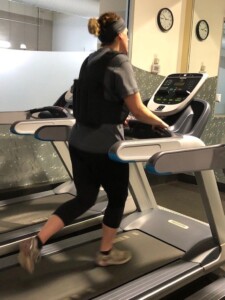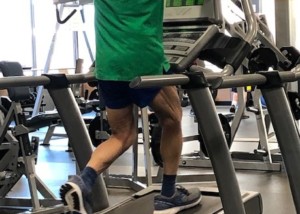
This article explains the benefits of the treadmill’s negative incline and why you should use it.
Many people want to know what the negative incline on a treadmill “is supposed to do.”
There are many reasons to use the negative incline of a treadmill, but it seems as though few treadmill enthusiasts use this function.
Whenever I see a treadmill with a negative incline function, the grade goes only as far down as minus-three.
However, that’s just enough to create a difference in the way the body moves when using the negative incline, versus zero grade.
When a person walks downhill, forces are placed upon the knee that aren’t there when walking up a hill, or on a flat course.
These forces are called “eccentric,” which you may have already heard of in terms of lifting weights (eccentric vs. concentric).
Nevertheless, eccentric training is very important for strengthening the legs.
Have you ever known someone who whips up a steep hill with little effort, but when it’s time to ambulate down, this individual struggles?
Or they complain of knee pain? They have not developed eccentric conditioning.
Walk for 10 minutes, at 3.5 to 4 mph, using a negative 3 percent incline on the treadmill. And swing your arms with some exaggeration.
I see most treadmill walkers holding on, and this unnatural way of walking will oppose any goals that you have.

Wrong, wrong and wrong.

More wrong.
If 3.5 mph is too fast for a walk, then try 3 to 3.2 mph — or even below 3 mph — depending on your fitness level. Just don’t hold on.
Jogging on the negative incline function of a treadmill is also a smart idea, as this will further develop eccentric conditioning, creating a stronger knee joint.
Even if you have a staircase in the house and think your knees are already strong from using the stairs every day, the difference with the treadmill’s negative incline is that you’d be using it continuously for a predetermined amount of time.
Going down a staircase takes 5-10 seconds, and then it’s over. Even if this is repeated throughout the day, it’s still 5-10 seconds at a time, which cannot be compared to 10 nonstop minutes on the treadmill.
For an interesting calve stretch, walk backwards using the treadmill’s negative incline (always at its maximum of 3 percent, since this is a minimal decline).
Now here’s the tricky part, though it actually should not be tricky at all.
Everyone I see who walks backwards on a treadmill holds on. When I was a personal trainer, I had my clients let go and swing their arms.
This makes them upright with square shoulders and a solid gait, because by not holding on for assistance, they are making their entire body work to keep balanced and centered. This neuromuscular recruitment is extremely important.
Start out at 1 to 1.5 mph, and begin walking backwards without holding onto the rails.
You’ll feel that your legs have to work in a unique way, but that’s the whole idea, and you don’t want to snuff out this recruitment by holding onto the rails.
As you feel more comfortable, increase the speed, and swing the arms.
Watch your feet if this helps, or if you feel more at ease focusing on a point straight ahead, then do that.
One need not spend long periods of time using the treadmill’s negative incline to reap a training effect.
Ten minutes of walking on it, and 5-10 minutes of jogging on it, per week, will provide a nice touch to your cardio regimen.
 Lorra Garrick is a former personal trainer certified through the American Council on Exercise. At Bally Total Fitness she trained women and men of all ages for fat loss, muscle building, fitness and improved health.
Lorra Garrick is a former personal trainer certified through the American Council on Exercise. At Bally Total Fitness she trained women and men of all ages for fat loss, muscle building, fitness and improved health.
.

























